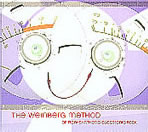|
|
 |
Dusted Reviews
Artist: Fred Weinberg Album: The Weinberg Method of Non-synthetic Electronic Rock Label: Normal Review date: Jul. 29, 2002 |

|
|
|
 |
When electronic music was fresh and eccentric, musicians and non-musicians were inspired by sound as never before. Hearing music became a potentially scientific endeavor, complete with laboratories full of equipment, bizarre experiments, and rational explanations of why an oboe possessed a unique timbre. Sound was at once available for deconstruction and reconstruction, and for many the sonic environment became worthy of attention. Gradually, electronic music shifted from the halls of academia and the garages of inventors to popular music—from Stevie Wonder to disco producer Giorgio Moroder to the Who. But the integration was not an entirely smooth one.
Exhibit A is Fred Weinberg’s 1970 obscurity The Weinberg Method of Non-Synthetic Electronic Rock. Judging by the title of the record, one senses that Weinberg felt a powerful need to disassociate his music from artificiality. For Weinberg, electronic music was fine, but synthetic music was repulsive. With this album, recently re-issued by Normal Records, Weinberg integrated recordings of his real-world sonic environment into a mixture of synthesizers and tape manipulations.
If Weinberg’s purpose was to engineer an album simultaneously exploiting the possibilities of electronic-scientific music and producing the visceral excess of late-60’s psychedelia, then The Weinberg Method succeeded, if a bit clumsily. Some of the tracks on the record merit description as worthy predecessors to Faust and the Yellow Magic Orchestra, or comparison to contemporaries like the pre-Kraftwerk outfit The Organisation or Raymond Scott. These gems include “Animosity,” a twisted and repetitive rock song with oddly treated vocals and bits of purposeful electronic manipulation. While it’s too short to be the masterpiece that is Faust’s “It’s a Rainy Day, Sunshine Girl,” it was certainly on the same track. Other songs, like “Muck de Foog,” reach an even stranger plateau, producing a hectic clash between slowed-down fragments and unstable synthesizer melodies. In contrast, “Theme for Julie” is powerfully simple, and has a grand melody. “Speedo” is a cover of a doo-wop song which includes a neat Jew’s harp breakdown. Weinberg sought to make electronic music something more than an experiment alone.
However, not every track remains compelling; “Aum Mau Mau” sounds like it could be in an Outback Steakhouse commercial or something. But this album was so stylistically varied that some of the songs were bound to fail. By and large The Weinberg Method is an interesting and listenable chapter in the history of electronic music.
The debate about reliance on electronics raged through the 70’s, as evidenced by the mass hatred of “fake music” like disco, and in the 80’s and 90’s in the resentment against rap, and even today with electronic musicians being derided as talentless button-pushers. This debate has a long history, and The Weinberg Method, largely unknown as it is, has a crucial place in it. Here was an album which predated much of the integration of electronics into functional or popular music, carrying with it an explicitly stated desire to be “non-synthetic.” For Fred Weinberg, novel electronic instrumentation was inextricably wedded to a deeper understanding of sound and an overt accessibility.
By Ben Tausig
|







